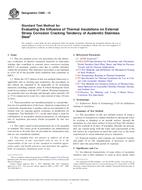Potřebujeme váš souhlas k využití jednotlivých dat, aby se vám mimo jiné mohly ukazovat informace týkající se vašich zájmů. Souhlas udělíte kliknutím na tlačítko „OK“.
ASTM C692-13
Standard Test Method for Evaluating the Influence of Thermal Insulations on External Stress Corrosion Cracking Tendency of Austenitic Stainless Steel
Automaticky přeložený název:
Standardní zkušební metoda pro hodnocení vlivu tepelných izolací na vnější korozní praskání tendence austenitická nerezová ocel
NORMA vydána dne 1.5.2013
Informace o normě:
Označení normy: ASTM C692-13
Poznámka: NEPLATNÁ
Datum vydání normy: 1.5.2013
Kód zboží: NS-14632
Počet stran: 8
Přibližná hmotnost: 24 g (0.05 liber)
Země: Americká technická norma
Kategorie: Technické normy ASTM
Kategorie - podobné normy:
Anotace textu normy ASTM C692-13 :
Keywords:
austenitic stainless steel, chloride, Dana test, Drip test, external stress corrosion cracking (ESCC), qualification test, thermal insulation, wicking insulation, ICS Number Code 91.100.60 (Thermal and sound insulating materials)
Doplňující informace
| Significance and Use | ||||||||||||
|
5.1 An inherent characteristic of some alloys of austenitic stainless steel is their tendency to crack at stress points when exposed to certain corrosive environments. The mechanisms of ESCC are complex and not completely understood but are apparently related to certain metallurgical properties. Chloride and fluoride ions have the potential to induce stress corrosion cracking in the absence of inhibiting ions.5.2 Chlorides are common to many environments, so great care shall be taken to protect austenitic stainless steel from chloride contamination. 5.3 Most thermal insulations will not, of themselves, cause stress corrosion cracking. Preproduction qualification tests are used to evaluate that under the conditions of the laboratory test that specific thermal insulation materials do not cause cracking of sensitized austenitic stainless steel. Insulation systems have the potential to act as collecting media by means of transmigration and concentration of corrosive ions on heated stainless steel surfaces. Exposure to elevated temperature results in evaporation of water and increased chemical reaction rates. Environments containing corrosive ions, moisture, and oxygen will increase the chance for stress corrosion cracking. 5.4 Insulation materials are available that are specially formulated to inhibit stress corrosion cracking in the presence of chlorides through modifications in basic composition or incorporation of certain chemical additives. 5.5 The ability of the 28-day test to measure the corrosion potential of insulation materials is documented by Karnes,5.6 The metal for all of the coupons used in this test method (C692) shall be qualified (see Section 1.1 This test method covers two procedures for the laboratory evaluation of thermal insulation materials to determine whether they contribute to external stress corrosion cracking (ESCC) of austenitic stainless steel due to soluble chlorides within the insulation. This laboratory procedure is not intended to cover all of the possible field conditions that contribute to ESCC. 1.2 While the 1977 edition of this test method (Dana test) is applicable only to wicking-type insulations, the procedures in this edition are intended to be applicable to all insulating materials, including cements, some of which disintegrate when tested in accordance with the 1977 edition. Wicking insulations are materials that wet through and through when partially (50 to 75 %) immersed in water for a short period of time (10 min or less). 1.3 These procedures are intended primarily as a preproduction test for qualification of the basic chemical composition of a particular manufacturer's product and are not intended to be routine tests for ongoing quality assurance or production lot compliance. Test Methods C871, on the other hand, is used for confirmation of acceptable chemical properties of subsequent lots of insulation previously found acceptable by this test method. 1.4 The values stated in inch-pound units are to be regarded as standard. The values given in parentheses are mathematical conversions to SI units that are provided for information only and are not considered standard. 1.5 This standard does not purport to address all of the safety concerns, if any, associated with its use. It is the responsibility of the user of this standard to establish appropriate safety and health practices and determine the applicability of regulatory limitations prior to use. |
||||||||||||
| 2. Referenced Documents | ||||||||||||
|
Podobné normy:
Historická
1.5.2013
Historická
1.9.2011
Historická
1.9.2010
Historická
1.11.2011
Historická
1.5.2014
Historická
1.4.2010



 ASTM G46-94(2013)..
ASTM G46-94(2013).. ASTM G48-11
ASTM G48-11 ASTM G50-10
ASTM G50-10 ASTM G52-00(2011)..
ASTM G52-00(2011).. ASTM G61-86(2014)..
ASTM G61-86(2014).. ASTM G73-10
ASTM G73-10
 Cookies
Cookies
